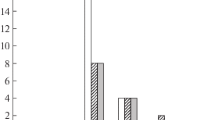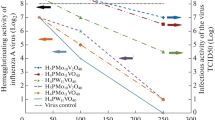Summary
The mechanism of transfection enhancement by protamine and histone was investigated, using poliovirus RNA and sheet cultures of the CLI line of chimpanzee liver cells. The transfection obtained using inocula prepared by premixing the viral RNA with a large excess of basic protein could be quantitatively accounted for by direct sensitization of the cells by the excess free basic protein postinoculation. Such direct sensitization to transfection was very rapid; at 25 °C with protamine chloride or histone at 1 mg/ml peak sensitivity was reached in about 16 and 25 seconds, respectively. Sensitivity then rapidly decreased, but could be partially restored later by a second pretreatment with fresh basic protein. The original sensitization, desensitization, and resensitization phases of the cell sensitivity curves are transfectionspecific, since ordinary infection with intact poliovirions was not influenced by the pretreatments with basic protein, except that prolonged pretreatment with histone decreased sensitivity to intact virus. The viral RNA transfectivity in inocula premixed with protamine chloride at 1 mg/ml and held at 0 °C was labile, with an initial half-life of only 5 minutes; the transfectivity of RNA similarly held in buffer alone or with histone was completely stable at 0 °C for at least 1.5 to 2 hours. With the best basic protein transfection method (cell sensitization by protamine), the specific transfectivity of RNA isolated from purified poliovirions was 130,000 plaque-forming units/μg RNA.
Similar content being viewed by others
References
Al-Moslih, M. I., Dubes G. R., 1973 a: The kinetics of DEAE-dextran-induced cell sensitization to transfection. J. gen. Virol.18, 189–193.
— —, 1973 b: Orthophosphate and amino acids as nutritional factors stimulating diethylaminoethyl-dextran-induced cell sensitization to transfection. Arch. Ges. Virusforsch.41, 71–79.
Amos, H., Kearns, K. E., 1962: Synthesis of “bacterial” protein by cultured chick cells. Nature195, 806–808.
— —, 1963: Influence of bacterial ribonucleic acid on animal cells in culture. II. Protamine enhancement of RNA uptake. Exp. Cell Res.32, 14–25.
Aoki, S., Takebe, I., 1969: Infection of tobacco mesophyll protoplasts by tobacco mosaic ribonucleic acid. Virology39, 439–448.
Benzinger, R., Kleber, I., Huskey, R., 1971: Transfection ofEscherichia coli spheroplasts. I. General facilitation of double-stranded deoxyribonucleic acid infectivity by protamine sulfate. J. Virol.7, 646–650.
Chapin, M., Dubes, G. R., 1964: Characteristics of five rhesus monkey kidney cell lines. Proc. Soc. exp. Biol. Med. (N.Y.)115, 965–970.
Chin, P. H., Silverman, M. S., 1967: Studies on the transfer of myeloma protein synthesis with RNA isolated from the C3H plasma cell tumor (X 5563). I. Uptake of isotopically labeled tumor RNA by lymphoid cells. J. Immunol.99, 476–488.
Connolly, J. H., 1966: Effect of histones and protamine on the infectivity of Semliki Forest virus and its ribonucleic acid. Nature212, 858.
Douglas, J. D., Vasington, P. J., Noel, J. K., 1966: Viral spectrum of an established chimpanzee liver cell line. Proc. Soc. exp. Biol. Med. (N.Y.)121, 824–829.
Dubes, G. R., 1971: Methods for transfecting cells with nucleic acids of animal viruses: a review. Pages 67–70. Experientia Supplementum 16. Basel and Stuttgart: Birkhäuser-Verlag.
Dubes, G. R., 1974: Strong inhibition of transfection by critical low concentration of diethylaminoethyl-dextran. Acta Virol.18, 457–466.
- 1975 a: Stabilization of poliovirion RNA transfectivity by histidine. Abstr. ann. Mtg. amer. Soc. Microbiol., p. 228.
—, 1975 b: Reciprocal antagonism of two transfection methods. Arch. Virol.48, 271–274.
-Wegrzyn, R. J., 1977: Evanescence of basic protein-induced sensitization of primate cells to transfection. Abstr. ann. Mtg. amer. Soc. Microbiol., p. 360.
Dulbecco, R., Vogt, M., 1954: Plaque information and isolation of pure lines of poliomyelitis viruses. J. exp. Med.99, 167–182.
Henner, W. D., Kleber, I., Benzinger, R., 1973: Transfection ofEscherichia coli spheroplasts. III. Facilitation of transfection and stabilization of spheroplasts by different basic polymers. J. Virol.12, 741–747.
Hotz, G., Mauser, R., 1969: Infectious DNA from coliphage T 1. I. Some properties of the spheroplast assay system. Molec. gen. Genetics104, 178–194.
Koch, G., 1971: Stability of polycation-induced cell competence for infection by viral RNA. Virology45, 841–843.
—,Bishop, J. M., 1968: The effect of polycations on the interaction of viral RNA with mammalian cells: Studies on the infectivity of single- and double-stranded poliovirus RNA. Virology35, 9–17.
Leonard, C. G., Cole, R. M., 1972: Purification and properties of streptococcal competence factor isolated from chemically defined medium. J. Bacteriol.110, 273–280.
Ludwig, E. H., Smull, C. E., 1963: Infectivity of histone-poliovirus ribonucleic preparations. J. Bacteriol.85, 1334–1338.
Melechen, N. E., Hudnik-Plevnik, T. A., Pfeifer, G. S., 1972: Increased stability and reproducibility ofEscherichia coli spheroplasts in the transfection assay of phage lambda DNA with polyethylene glycol instead of sucrose. Virology47, 610–617.
Olenov, J. M., 1968: Transformationlike phenomena in somatic cells. Int. Rev. Cytol.23, 1–23.
Pakula, R., Ray, P., Spencer, L. R., 1970: Some characteristics of streptococci competent for uptake of deoxyribonucleic acid. Canad. J. Microbiol.16, 345–350.
Paranchych, W., 1963: Assay of infectious RNA from bacteriophage R 17. Biochem. biophys. Res. Commun.11, 28–33.
Parish, J. H., 1972: Principles and practice of experiments with nucleic acids, p. 173. London: Longman Group Limited.
Schindler, J., 1966: Inhibition of the infective activity of phage f2 and its infectious RNA by histone. Experientia22, 159–160.
Sellers, M. I., Tokunaga, T., 1966: Further studies of infectious DNA extracted from mycobacteriophages. J. exp. Med.123, 327–340.
Smull, C. E., Ludwig, E. H., 1962: Enhancement of the plaque-forming capacity of poliovirus ribonucleic acid with basic proteins. J. Bacteriol.84, 1035–1040.
—,Mallette, M. F., Ludwig, E. H., 1961: The use of basic proteins to increase the infectivity of enterovirus ribonucleic acid. Biochem. biophys. Res. Commun.5, 247–249.
Wackernagel, W., 1972: An improved spheroplast assay for lambda DNA and the influence of bacterial genotype on the transfection rate. Virology48, 94–103.
Author information
Authors and Affiliations
Rights and permissions
About this article
Cite this article
Dubes, G.R., Wegrzyn, R.J. Rapid ephemeral cell sensitization as the mechanism of histone-induced and protamine-induced enhancement of transfection by poliovirus RNA. Protoplasma 96, 209–223 (1978). https://doi.org/10.1007/BF01287683
Received:
Accepted:
Issue Date:
DOI: https://doi.org/10.1007/BF01287683




